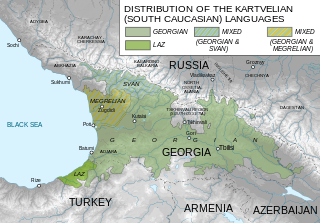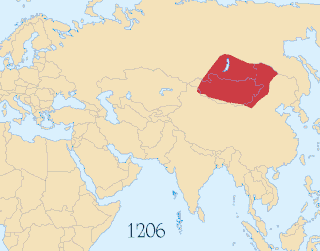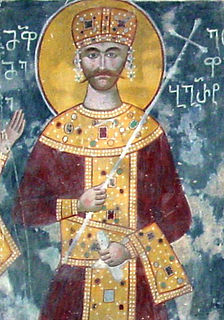Ivane-Qvarqvare Jaqeli-Tsikhisjvareli (Georgian :ივანე-ყვარყვარე ჯაყელი-ციხისჯვარელი; died c. 1247 [1] ) was a Georgian nobleman of the Jaqeli family, who served as eristavi ("duke") and spasalar ("constable") of Samtskhe in the early 13th century. Rising to prominence thanks to his loyal service to Queen-Regnant Tamar of Georgia, Ivane Jaqeli's long career spanned pivotal years in the history of medieval Georgia, through the "Golden Age" to the crisis and decline under the Mongol hegemony.

Georgian is a Kartvelian language spoken by Georgians. It is the official language of Georgia. Georgian is written in its own writing system, the Georgian script. Georgian is the literary language for all regional subgroups of Georgians, including those who speak other Kartvelian languages: Svans, Mingrelians and the Laz.

The Kingdom of Georgia, also known as the Georgian Empire, was a medieval Eurasian monarchy which emerged circa 1008 AD. It reached its Golden Age of political and economic strength during the reign of King David IV and Queen Tamar the Great from 11th to 13th centuries. Georgia became one of the pre-eminent nations of the Christian East, her pan-Caucasian empire stretching, at its largest extent, from Eastern Europe and the North Caucasus to the northern portion of Iran and Anatolia, while also maintaining religious possessions abroad, such as the Monastery of the Cross in Jerusalem and the Monastery of Iviron in Greece. It was the principal historical precursor of present-day Georgia.

Eristavi was a Georgian feudal office, roughly equivalent to the Byzantine strategos and normally translated into English as "duke". In the Georgian aristocratic hierarchy, it was the title of the third rank of prince and governor of a large province. Holders of the title were ex-officio commanders of a military 'banner', wore a distinctive dress, ring, belt and spear and rode a particular breed of horse.
Ivane, otherwise known as Qvarqvare, first appears in the medieval Georgian chronicles as bearing the surname Tsikhisjvareli, derived from the territorial epithet "of Tsikhisjvari". During a revolt of Queen Tamar's disgraced husband, George the Rus', around 1191, Ivane was one of the few nobles of Samtskhe who remained loyal to the queen. He might have become duke and constable of Samtskhe after the previous occupant of these offices, Botso Jaqeli, fell out of favor with Tamar for having supported George's attempted coup. Ivane was Botso's kinsman, member of the family cognate with that of Botso, [2] or even his brother. [1]
Yury Bogolyubsky, known as Giorgi Rusi in the Kingdom of Georgia, was a Rus' prince of Novgorod (1172–1175). He was married to King Tamar of Georgia from 1185 until being expelled from the kingdom in 1188.
Botso Jaqeli was a Georgian nobleman of the Jaqeli family, the first to have the rank of eristavi ("duke") of Samtskhe. He lost his positions for having joined an aristocratic revolt against Queen Tamar of Georgia.
By 1220, under Tamar's successor, George IV Lasha, Ivane, in addition to his tenure in Samtskhe, was also mechurchlet-ukhutsesi ("Lord High Treasurer") at the Georgian court. [3] When the Mongol armies moved in for the final conquest of Georgia in 1236, Ivane offered them stiff resistance and fought on until Queen Rusudan consented to a truce, in contrast to most Georgian grandees, who either surrendered without fighting or fled the Mongol advance to safer areas. The queen herself had escaped to western Georgia and did not return to the capital until being convinced to do so by the leading nobles of the kingdom, Ivane included, around 1243. [4]

George IV, also known as Lasha Giorgi (1191–1223), of the Bagrationi Dynasty, was a king of Georgia from 1213 to 1223.

The Mongol Empire existed during the 13th and 14th centuries and was the largest contiguous land empire in history. Originating from Mongolia, the Mongol Empire eventually stretched from Eastern Europe and parts of Central Europe to the Sea of Japan, extending northwards into Siberia, eastwards and southwards into the Indian subcontinent, Indochina and the Iranian Plateau; and westwards as far as the Levant and the Carpathian Mountains.

Rusudan, a member of the Bagrationi dynasty, ruled as Queen Regnant of Georgia in 1223–1245.
After Rusudan's death in 1245, while the Georgians were waiting for her successor to be confirmed by the Mongol Great Khan, the Mongols divided Georgia into several administrative units, tumens, run by local aristocracy. It is not known whether Ivane was at the head of any of these tumens, but during this period of interregnum he was the one whom the nobles of Georgia's southwestern marches, such as Tao, Klarjeti, Kola, and Artaani, solicited support against the invading Anatolian Turks. At the head of 10,000 troops, Ivane won a victory at the Avni plain and sent his grandsons—Ivane-Papa and Sargis—to chase the retreating Turks beyond the Georgian borders [4] and seize Oltu, which was probably under Ayyubid control at this point. [5] Further conquests are mentioned by the Arabic chronicler Baybars al-Mansuri, who states that the Georgians, apparently meaning the Jaqeli, profited from the Mongol invasion of Anatolia to take hold of Babrawan (Georgian Marmovani, modern Narman, south of Oltu), Washlawan (Georgian Vashlovani, of unknown location in Tao), and Bayburt. [5]
Tumen, or tümen, was a part of the decimal system used by the Turkic peoples and Mongol peoples to organize their armies. Tumen is an army unit of 10,000 soldiers.

Tao is a historical Georgian district and part of historic Tao-Klarjeti region, today part of the Eastern Anatolia region of Turkey. Its name derives from the ancient proto-Georgian inhabitants of this area, known as Taochi.

The Klarjeti was a province of ancient and medieval Georgia, which is now part of the Turkey's Artvin Province. Klarjeti, the neighboring province of Tao and several other smaller districts constituted a larger region with shared history and culture conventionally known as Tao-Klarjeti.
Shortly afterwards, Ivane participated in a failed plot to overthrow the Mongol hegemony. In 1247, Ivane was among those nobles, who, alarmed by a protracted interregnum, sought out and brought back to Georgia the exiled prince David, son of the late king George IV. [6] Ivane-Qvarqvare might have died around that time, outliving his son Beka, who was killed in a battle with the Mongols in 1220 [7] or 1221, [1] [5] and, possibly, the eldest grandson Ivane (also known as Papa). The next known duke of Samtskhe was Ivane-Qvarqvare's younger grandson, Sargis Jaqeli. [6]

David VII, also known as David Ulu (1215–1270), from the Bagrationi dynasty, was king of Georgia from 1247 to 1270, jointly with his namesake cousin, David VI, from 1247 to 1259, when David VI, revolting from the Mongol hegemony, seceded in the western moiety of the kingdom, while David VII was relegated to the rule of eastern Georgia. During his reign, Georgia went into further decline under the Mongol overlordship.







